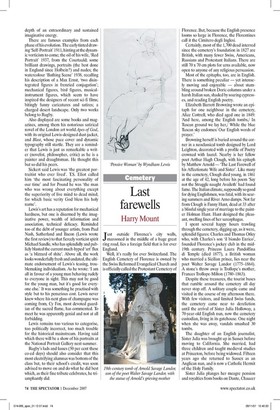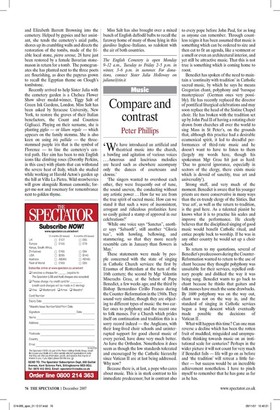Last farewells
Harry Mount Just outside Florence's city walls, marooned in the middle of a huge great ring road, lies a foreign field that is for ever England.
Well, it's really for ever Switzerland. The English Cemetery of Florence is owned by the Swiss Reformed Evangelical Church and is officially called the Protestant Cemetery of Florence. But, because the English presence looms so large in Florence, the Florentines call it the Cimitero degli Inglesi.
Certainly, most of the 1,700 dead interred since the cemetery's foundation in 1827 are British, with many fewer Swiss, Americans, Russians and Protestant Italians. There are still 70 x 70 cm plots for urns available, now open to anyone of any religious persuasion.
Most of the epitaphs, too, are in English. There is something peculiar — yet intensely moving and enjoyable — about stumbling around broken Doric columns under a harsh Italian sun, shaded by soaring cypresses, and reading English poetry.
Elizabeth Barrett Browning wrote an epitaph for one neighbour in the cemetery, Alice Cottrell, who died aged one in 1849: 'And here, among the English tombs,/ In Tuscan ground we lay her,/ While the blue Tuscan sky endomes/ Our English words of prayer.'
Browning herself is buried around the corner in a neoclassical tomb designed by Lord Leighton, decorated with a profile of Poetry crowned with laurel. Nearby is her fellow poet Arthur Hugh Clough, with his epitaph by Matthew Arnold — 'The Last Farewell of his Affectionate Wife and Sister'. Like many in the cemetery, Clough died young, in 1861 at the age of 42, long before his poem 'Say not the Struggle naught Availeth' had found fame. The Italian climate, supposedly so good for dying Englishmen, was fatal, with its searing summers and River Arno damps. Not far from Clough is Fanny Hunt, dead at 33 after a blissful single year of marriage to the painter Holman Hunt. Hunt designed the pleasant, swelling lines of her sarcophagus.
I spent several happy hours trawling through the cemetery, digging up, as it were, splendid figures: Charles and Thomas Otley who, with Charles's son `il biondo Enrico', founded Florence's jockey club in the mid19th century. Princess Laura Pandolfina di Temple (died 1877), a British woman who married a Sicilian prince, lies near the poet Walter Savage Landor (1775-1864). A stone's throw away is Trollope's mother, Frances Trollope-Milton (1780-1863).
Despite these treasures, the tourist buses that rumble around the cemetery all day never stop off. A solitary couple came and visited in the course of my afternoon there. With few visitors, and limited Swiss funds, the cemetery came near to dereliction until the arrival of Sister Julia Holloway, a 70-year-old English nun, now the cemetery custodian, living in its gatehouse. One night when she was away, vandals smashed 30 tombs.
The daughter of an English journalist, Sister Julia was brought up in Sussex before moving to California. She married, had three children and taught medieval studies at Princeton, before being widowed. Fifteen years ago she returned to Sussex as an Anglican nun, and is now a Catholic Hermit of the Holy Family.
Sister Julia plunges her meagre pension and royalties from books on Dante, Chaucer and Elizabeth Barrett Browning into the cemetery. Helped by gypsies and her assistant, she tends the cemetery's axial paths, shores up its crumbling walls and directs the restoration of the tombs, made of the friable local stone, pietra serena; 28 have just been restored by a female Bavarian stonemason in return for a tomb. The pomegranates she has planted next to the three poets are flourishing, as does the papyrus grown to recall the Egyptian theme on Clough's tombstone.
Recently arrived to help Sister Julia with the cemetery garden is a Chelsea Flower Show silver medal-winner, Tiggy Salt of Green Ink Gardens, London. Miss Salt has been asked by Syracuse University, New York, to restore the graves of their Italian benefactors, the Count and Countess Gigliucci. Playing on their surname, she is planting giglio — or lilium regale — which appears on the family stemma. She is also keen on using iris pallida — the threestemmed purple iris that is the symbol of Florence — to line the cemetery's central path. Her aim has been to mix English icons like climbing roses (Dorothy Perkins, in this case) with plants that can withstand the severe heat of Italy, which she studied while working at Harold Acton's garden up the hill at Villa La Pietra. Wild strawberries will grow alongside Roman camomile; forget-me-not and rosemary for remembrance next to golden thyme.
Miss Salt has also brought over a mixed bunch of English daffodil bulbs to recall the faraway home of many of those lying in this giardino Inglese–Italiano, so redolent with the air of both countries.
The English Cemetery is open Monday 9-12 a.m., Tuesday to Friday 2-5 p.m. in winter, 3-6 p.m. in summer. For dona- tions, contact Sister Julia Holloway on juliana@tin.it






































































 Previous page
Previous page